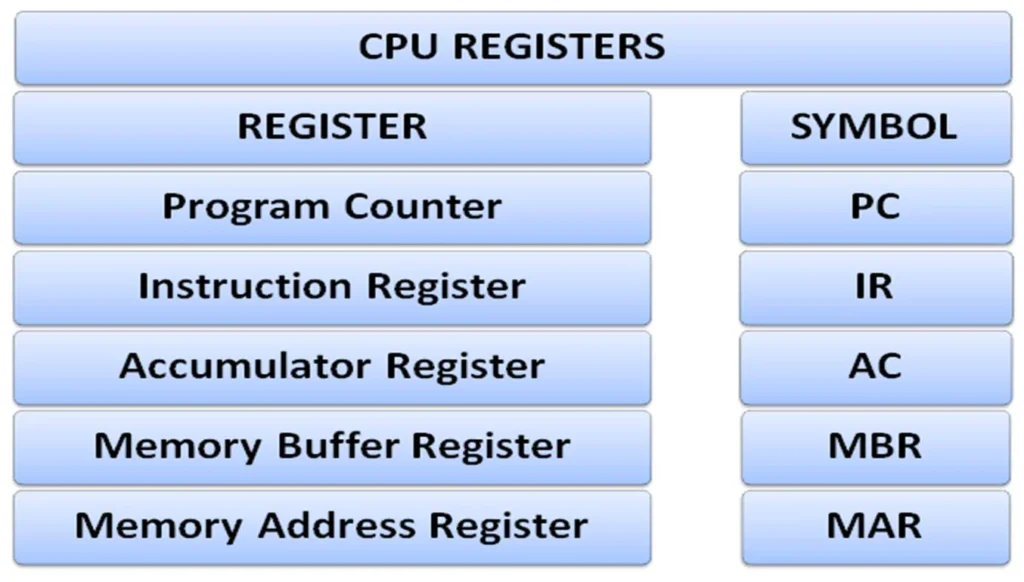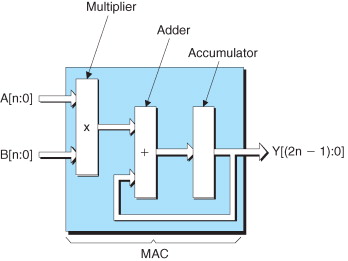Registers are small, fast storage locations within the CPU that temporarily hold data, instructions, and memory addresses. They enable the CPU to quickly access and process information, making them essential for efficient program execution. Different types of registers serve specific functions, helping the CPU perform tasks at high speeds. Understanding these registers is key to grasping how a CPU manages and processes data efficiently.
“Registers in a CPU are small, high-speed storage locations directly inside the processor used to temporarily hold data, instructions, and addresses. They enable quick data access and efficient execution of tasks.”
In this Article, We will discuss “What Are The Registers In A Cpu”.
Table of Contents
Types of Registers in a CPU:

Data Registers:
Purpose: Data registers hold data that is being processed or transferred between different parts of the CPU or between the CPU and memory. These registers are essential during computations, as they temporarily store intermediate results or final outputs of arithmetic or logical operations.
Examples:
- General-Purpose Registers (GPRs): These are the most commonly used registers in a CPU. They store data that can be accessed and manipulated by the processor. For example, in the x86 architecture, registers like EAX, EBX, ECX, and EDX are general-purpose registers.
- Special-Purpose Registers: These include registers used for specific tasks, such as storing flags or counters.
Address Registers:
Purpose: Address registers hold memory addresses, which are pointers to data locations in memory. These are used to retrieve data from memory or to write data to specific memory locations.
Examples:
- Instruction Pointer (IP) / Program Counter (PC): This register stores the address of the next instruction to be executed by the CPU. It helps the CPU follow the sequence of instructions in a program.
- Stack Pointer (SP): The stack pointer holds the memory address of the top of the stack, a special region in memory used for storing return addresses, local variables, and function parameters during function calls.
- Base Register: It holds a base address in memory, which is used as an offset for addressing data in segmented memory systems.
- Index Register: It is used to store offsets or addresses when accessing arrays or data structures.
Also Read: Best Budget CPU – Top Budget CPUs For Performance & Price!
Control Registers:
Purpose: These registers are used to control and monitor the execution of a program or the CPU itself. They play a vital role in managing how the CPU interacts with memory, I/O devices, and other system components.
Examples:
- Status Register (Flags Register): This register contains bits that reflect the status of the CPU, such as the result of the most recent arithmetic or logical operation. It includes condition flags such as Zero, Carry, Sign, and Overflow flags.
- Control Register (e.g., CR0 in x86): It is used to control various processor states and modes, such as enabling or disabling paging or setting protection levels.
- Interrupt Flag (IF): The interrupt flag determines whether interrupts are enabled or disabled, controlling how the CPU responds to external interrupts.
Accumulator Register:

Purpose: The accumulator register is often used in arithmetic and logic operations as a primary storage location for results. Many processors optimize operations by using the accumulator for common operations like addition or subtraction.
Examples:
- EAX register in x86: This is a common accumulator register, storing the results of calculations, such as arithmetic operations or function returns.
Program Status Word (PSW) / Flags Register:
Purpose: The PSW is a special register that contains information about the state of the CPU. It includes flags that indicate various conditions or status after a computation, such as whether the result was zero, whether there was a carry-out in arithmetic, or whether an overflow occurred.
Flags in PSW/Flags Register: Some of the common flags are:
- Zero Flag (ZF): Set if the result of an operation is zero.
- Carry Flag (CF): Set if there is a carry-out or borrow in an operation.
- Sign Flag (SF): Indicates whether the result of an operation is positive or negative.
- Overflow Flag (OF): Set if an arithmetic overflow occurs, meaning the result exceeds the register’s size.
Index Register:
Purpose: The index register is used for indexing into memory locations, typically when accessing arrays or other structured data. It helps calculate memory addresses using an index value.
Examples: The SI (source index) and DI (destination index) registers in the x86 architecture serve this purpose.
Also Read: Best Amd CPU – A Comprehensive Guide!
Special-Purpose Registers:
Purpose: These registers are designed for specific tasks, often related to system control, such as enabling interrupts or managing virtual memory.
Examples:
- Memory Management Registers: These registers are used to manage the translation of virtual addresses to physical addresses in systems with virtual memory.
- Control Registers for Virtual Memory (CR3 in x86): This register holds the address of the page directory, which is used in paging to translate virtual memory addresses into physical memory addresses.
How Registers Work in CPU Operations:

- Fetching Instructions When a program is executed, the CPU fetches instructions from memory one at a time. The Program Counter (PC) holds the address of the next instruction to be fetched. The PC is incremented after each instruction is fetched, so the CPU knows which instruction to execute next.
- Decoding Instructions Once the instruction is fetched, it is decoded. The decoding process involves identifying the operation to be performed and determining the necessary operands. These operands may be stored in the CPU’s general-purpose registers or in memory.
- Executing Instructions The CPU performs the operation specified by the decoded instruction, using registers to hold intermediate values. For example, if the instruction is an addition, the CPU will read values from the relevant registers, perform the arithmetic, and store the result in a destination register.
- Storing Results After an operation is performed, the result is typically stored in one of the registers. The Accumulator or general-purpose registers are commonly used to store the results of arithmetic or logical operations. The Status Register is updated to reflect the condition of the result (whether it’s zero, negative, etc.).
- Handling Interrupts Registers also play an essential role in handling interrupts. When an interrupt occurs, the Interrupt Flag (IF) in the control register determines whether the CPU will respond to the interrupt or not. If interrupts are enabled, the CPU will save the current state of the execution, including the contents of key registers, and then jump to the interrupt service routine to handle the interrupt.
The Role of Registers in Performance:
Since registers are located directly within the CPU, they are the fastest form of memory. Their speed allows the CPU to access and manipulate data quickly, which is essential for the high-performance operation of modern processors. The use of registers minimizes the need to access slower memory like RAM or even cache, which would slow down processing times significantly.
In addition, the number and type of registers available in a CPU can impact the overall performance of the system. Processors with more registers, or with specialized registers for specific tasks (such as SIMD instructions), can perform certain operations more efficiently, especially for complex computations like those used in graphics processing, scientific simulations, or machine learning.
FAQ’s
1. What are registers in a CPU?
Registers are small, high-speed storage locations within the CPU that temporarily hold data, instructions, and memory addresses for quick access during processing.
2. Why are registers important in a CPU?
Registers are crucial because they allow the CPU to quickly access and manipulate data, speeding up the execution of instructions and improving overall system performance.
3. What are the different types of registers in a CPU?
Common types of registers include general-purpose registers, address registers, control registers, and status registers, each serving specific roles in data processing and instruction execution.
4. How do registers differ from other memory types like RAM?
Registers are much faster than RAM and are directly within the CPU, allowing for immediate access, while RAM is slower and located outside the CPU.
5. Can a CPU function without registers?
No, registers are essential for a CPU to function effectively, as they store critical data and instructions that the processor needs to execute tasks.
Conclusion
In conclusion, registers are essential components of a CPU, enabling quick data access and efficient execution of instructions. They play a vital role in improving processing speed by temporarily holding critical information during computations. Understanding registers helps us appreciate how CPUs manage tasks and optimize system performance.

